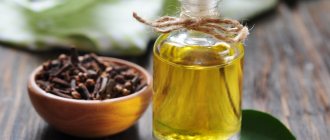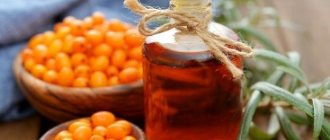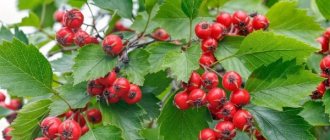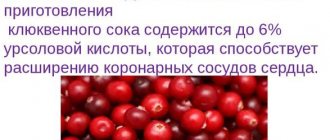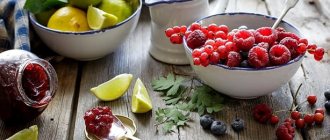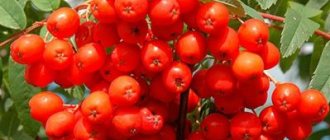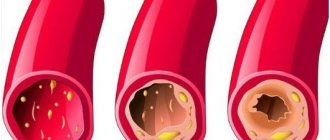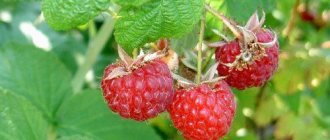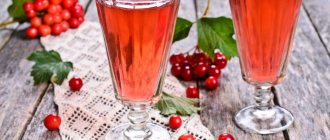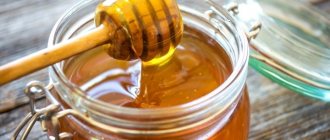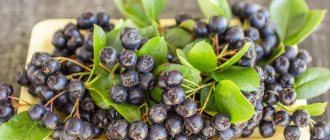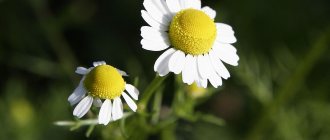Honeysuckle wine at home
Honeysuckle berries are very tender. They choke even when poured from dish to dish. Damaged berries do not look as appetizing, but they are suitable for processing. You can make wine from them.
- Grind the berries in any way.
- For 1 kg of puree add 50 g of sugar.
- Leave the mixture for 3 days in a warm place.
- Squeeze out the juice and pour it into a fermentation bottle.
- Pour water into the pulp in an amount equal to the drained juice.
- After 3 days, squeeze out the cake and add the drained juice to the fermentation bottle.
- Add sugar (200 g/l of liquid) there and place a water seal.
- When fermentation subsides, add sugar (200 g/liter).
- After fermentation is complete, the wine is drained and stored in the cold for no more than a month.
Chemical composition
Honeysuckle contains:
- simple and complex carbohydrates;
- organic acids (malic, ethanedioic, butanedioic, citric);
- vitamins B1, B2, C, A, P;
- micro and macroelements (potassium, calcium, phosphorus, magnesium, iodine, aluminum, sodium, manganese, copper, iron).
All vitamins in honeysuckle have their own functions:
- Ascorbic acid promotes iron metabolism, the formation of connective tissue, and is a strong antioxidant.
- B vitamins take part in protein, carbohydrate and fat metabolism in the body and have a beneficial effect on the nervous system and gastrointestinal functions. Effective for inflammatory eye diseases.
- Vitamin A is necessary for the synthesis of collagen in the body and maintenance of vision.
Microelements are also important for the body:
- Copper promotes the absorption of iron, the prevention of anemia, dermatoses:
- Potassium takes part in photosynthesis, is present in the intercellular substance, and helps in the transmission of nerve impulses to muscles.
- Calcium promotes contraction of skeletal and cardiac muscles. The element is necessary for blood clotting and the functioning of the nervous system, and is part of bones and cartilage tissue.
- Phosphorus promotes the formation of bone tissue, normal functioning of the cardiovascular system, regulates acid-base balance, and helps with the synthesis of hormones and enzymes within the body.
- Magnesium improves immunity and regulates the functioning of all systems.
- Iodine improves muscle tone and promotes the development of cognitive skills.
Bioflavonoids help strengthen the walls of blood vessels and prevent hemorrhages.
All organic substances have a complex therapeutic effect on the body and prevent the development of new pathologies.
What are the benefits of honeysuckle for the human body?
This is a common plant in which each part has a lot of beneficial properties. In folk medicine, garden honeysuckle has been used since ancient times to prepare various drinks, decoctions, and infusions that help the cardiovascular, genitourinary, and digestive systems. Fruits, branches, bark, flowers, leaves are useful.
Used for the treatment and prevention of various diseases. The healing properties of honeysuckle are known to many - it helps with heart disease, colds, and digestive problems. Has the following beneficial effects:
- Helps remove harmful substances and toxins from the body.
- Normalization of blood pressure, improvement of heart muscle function.
- Positive effect on the functioning of brain structures.
- Increasing the body's resistance to penetration and development of infectious lesions.
- Eliminate headaches.
- Helps with metabolic processes and digestion.
- Reducing the likelihood of atherosclerotic plaques and blood clots.
The berries will be useful for diabetes, high blood pressure, colds, infectious diseases, and high cholesterol.
It gains its beneficial properties for men and women in a very short time, so it is usually collected in early to mid-June, especially in the southern regions.
For men
The benefits of honeysuckle for men are beyond doubt, because it is rich in vitamins A, B, C, and minerals. It also contains amino acids, pectins, and glycosides. It is often recommended for men over 40 who suffer from hair loss.
It will also be useful for diabetics, since the berries have a positive effect on metabolic processes and are low in calories. The composition also includes pectins, which help with irritated gastric mucosa during the digestion of heavy foods and in cases of poisoning. You can also use honeysuckle to normalize blood pressure.
For women
Honeysuckle berries have particular benefits for women. The berries contain antioxidants that slow down the aging process of cells and improve the condition of the skin. If you eat them periodically, you can achieve overall health of the body, as well as preserve beauty longer. The benefits of honeysuckle berries are enhanced if consumed fresh.
Advice! Honeysuckle is also beneficial for the female figure, so it is often recommended for those who want to lose weight. The reason for this is the acceleration of metabolism and the low calorie content of berries.
During pregnancy
The benefits of honeysuckle during pregnancy are due to its composition. Its positive properties allow:
- Reduce the likelihood of edema formation.
- Improve and stabilize the functioning of the cardiovascular system.
- Eliminate the deficiency of beneficial microorganisms and vitamins in the body of a pregnant woman.
To do this, you need to eat several honeysuckle berries on an empty stomach before each meal.
Nursing mother
Harm to honeysuckle during breastfeeding can only occur in one case - if the nursing mother eats the berries in the first months of the child's life. Doctors recommend starting to use these fruits with beneficial properties six months after the birth of the baby.
The mother should add them to her diet gradually, a few berries at a time, monitoring the baby’s reaction. In the absence of allergies, stomach problems and other unpleasant manifestations, honeysuckle can be eaten on an ongoing basis. In this case, it will not cause any harm to the mother and child - only benefit.
Does honeysuckle lower or increase blood pressure?
Let's consider how honeysuckle acts on the human circulatory system: does it increase or decrease blood pressure, who is it useful and who is contraindicated?
Honeysuckle is a shrub with dark blue, bittersweet-tasting berries. In alternative medicine, all parts of the bush are used - the berries, leaves, flowers, young shoots. They are used to treat dozens of different diseases.
Composition and properties
Honeysuckle berries are rich in vitamins and minerals. To make it clear, they contain more vitamin C than lemon, and 1 cup of fresh or frozen fruits can provide the body with the daily requirement of iron and B vitamins, which:
- improve mental activity;
- increase concentration;
- strengthen memory.
In addition, honeysuckle:
- stops inflammatory processes;
- increases the level of leukocytes in the blood (“guardians” of health);
- strengthens vascular walls;
- activates the body's regenerative abilities;
- normalizes the activity of the central nervous system;
- increases immunity.
The berries, leaves and young shoots of this plant are used to treat:
- iron deficiency anemia;
- vascular pathologies;
- peptic ulcers of the stomach, duodenum;
- intestinal disorders;
- pancreatitis;
- liver failure;
- internal bleeding;
- gallbladder diseases;
- migraine;
- malaria.
A positive result from consuming berries, infusions and decoctions prepared from leaves or shoots is observed after 2-3 days. Beneficial substances have a cumulative effect, continuing to have a therapeutic effect on it even after cessation of treatment.
Effect on pressure
The plant blocks the synthesis of prostaglandins, which activate inflammatory reactions, which lead to spasm of blood vessels and narrowing of their lumen, which impairs blood circulation and increases internal pressure on the vascular walls. Blocking the production of this substance ensures an increase in the lumen of blood vessels and normalization of blood flow, resulting in a decrease in blood pressure levels. In addition, honeysuckle berries eliminate excess fluid from the body, which also affects blood pressure.
Honeysuckle fruits are useful, but hypotensive people should not consume them. This will lead to an even greater decrease in blood pressure and worsening well-being.
Mode of application
To treat hypertension, honeysuckle is used in different ways; it is used to prepare homemade antihypertensive “medicines”:
- Berry tincture. 50 g of berries are washed, placed in a bottle, and 0.5 liters of medical alcohol are added. Infuse in a dark place for 7 days, shaking the bottle periodically. The product is taken 1 tbsp. twice/day before meals.
- Water infusion. Crush 50 g of berries, add 200 ml of cold water, and place in the refrigerator. The next day you can take the medicine. It is used throughout the day every 2-3 hours. Daily dosage – 100 g.
- Berry decoction. Place a glass of berries in a saucepan and pour in 0.4 liters of boiling water. Cook over low heat until boiling. Cool. Take 5 times a day, 50 ml.
- Decoction of leaves. 30 g of dry leaves are poured into a glass of water. Prepare the decoction in a water bath for 10 minutes, then leave for 2 hours, then filter. Take 4 times/day, 1 tbsp. before meals.
- Bark decoction. 100 g of crushed bark is poured into half a liter of boiling water. Cook over low heat for 30 minutes, leave for half an hour, filter. Method of administration: 4 times a day, 15-20 ml, regardless of meals.
Adverse reactions
When using honeysuckle to treat hypertension, adverse reactions are rare. As a rule, they occur with excessive consumption of berries, infusions, and decoctions. They can appear:
- digestive disorders;
- skin rashes;
- hypotensive crisis.
Contraindications
Despite the fact that honeysuckle is a useful plant, it has contraindications for which it is not worth taking. These include:
- age up to 5 years;
- pollen allergy;
- hypotension;
- individual intolerance.
In conclusion, it must be said that honeysuckle is a unique plant that helps hypertensive patients quickly and without harm normalize blood pressure levels. But you should not use it in combination with hypotonic drugs, as this may lead to a hypotonic attack.
Natural storehouse of vitamins, macro- and microelements
The beneficial properties of honeysuckle are due to its unique composition. The table below shows the content of various vitamins, macro- and microelements in 100 grams of the edible part of the fruit.
VitaminsMicroelementsMacroelements
| Vitamin C | 150 mg | Silicon | 10 mg | Potassium | 70 mg |
| Beta carotene | 0.3 mg | Iron | 0.8 mg | Sodium | 35 mg |
| Vitamin A | 50 mcg | Copper | 90 mcg | Phosphorus | 35 mg |
| Vitamin B1 | 18 mcg | Aluminum | 90 mcg | Magnesium | 21 mg |
| Vitamin B2 | 18 mcg | Manganese | 90 mcg | Calcium | 19 mg |
| Strontium | 90 mcg | ||||
| Iodine | 1 mcg |
Perhaps the value of honeysuckle will be more clearly explained not by numbers, but by simple facts: there is no less vitamin C in the fruits of this shrub than in lemon, and a cup of fresh or frozen berries provides the body with the daily norm of iron and B vitamins (they help improve mental performance , strengthening memory, increasing vital activity).
Now let's move on to the main question: does honeysuckle lower blood pressure or increase it, does it bring harm or benefit to hypertensive and hypotensive patients?
The use of honeysuckle in folk medicine
The plant has long been used in folk medicine in the treatment and prevention of cardiovascular diseases, blood vessels of the head, skin, internal organs, and to normalize blood pressure. It is subjected to different processing methods: juice is squeezed out, decoctions, tinctures are made, dried, frozen. Doctors recommend adding dried leaves and flowers of the bush to tea when brewing in winter. This improves immunity and fills the body with vitamins.
It is advisable to consult a doctor before using honeysuckle on your own - its beneficial properties and contraindications may be different for each person. The characteristics of the body, previous diseases, and allergic reactions to the composition of the plant must be taken into account. It is possible that some recipes or recipes cannot be used
It is important to know that there are healthy edible honeysuckle (dark blue berries) and wild poisonous varieties (red or orange fruits)
For liver diseases
To eliminate pain in the liver and gall bladder, you need to grind two teaspoons of fresh or frozen berries of the plant with sugar and stir the resulting mass in a glass of warm water or tea. Drink slowly, in small sips, so that it is better absorbed. A decoction of dried berries cleanses and restores the liver: pour 100 grams of berries with 1 liter of boiling water and leave in a warm place for three hours, drink half a glass an hour before meals. For preventive purposes, it is useful to eat jam and jams from the fruits of the plant.
For the treatment of hypertension
Fresh or frozen berries are good for hypertension and for the prevention of atherosclerosis. In winter, you can use decoctions: pour 50 grams of dried berries into 0.5 liters of boiling water, let it brew for 4-5 hours and consume two tablespoons three times a day before meals. To maintain normal blood pressure, it is recommended to drink brewed leaves: pour 20 grams of dried leaves with a glass of boiling water and drink a tablespoon three times a day.
For stomach ulcers
For advanced gastric and gastrointestinal ulcers, it is highly not recommended to consume fresh honeysuckle juice; it increases acidity when gastric juice is released. Before treating stomach diseases, you should consult your doctor. It is better to treat stomach ulcers on your own with a decoction of the bark of the bush: pour 5 tablespoons of dried finely chopped bark or twigs with a glass of boiling water, leave in a water bath for 15 minutes, strain and drink 1-2 tablespoons warm half an hour before meals.
Tinctures
Berry tincture is widely used in the treatment of hypertension. It's easy to prepare:
- You need to take 50 g of berries, wash them, and put them in a bottle.
- Pour half a liter of vodka or alcohol.
- Close the bottle and place in a cool, dark place.
- Leave for a week, shake the bottle every day.
This medicine should be taken one tablespoon before breakfast and dinner.
You can also make a water infusion. To do this, rinse a glass of berries, crush them, pour a glass of cold water, and put them in the refrigerator. Take 100 g twice a day. You need to be treated in this way for 2 weeks.
Help for hypertension
Is it possible to use honeysuckle for blood pressure, how to use the shrub in the fight against high blood pressure? First of all, honeysuckle helps the heart, normalizes its functioning, but it is known that this organ is directly related to pressure surges. The next nuance is strengthening weak, damaged vessels, they are the main problem. High pressure tends to expand the veins and capillaries; low pressure, on the contrary, makes them weak and sluggish. Under the influence of honeysuckle decoction, the blood vessels will gradually be restored and strengthened, therefore, the risk of stroke and crisis is reduced.
Honeysuckle restores veins and calms the nervous system
How does honeysuckle affect blood pressure, how many berries do you need to eat or drink a decoction to forget about the disease forever? Similar questions are often asked to doctors and pharmacists; there is no immediate cure for high blood pressure; it is impossible to quickly restore what has been destroyed for many years. The natural healer will gradually restore the veins, calm the nervous system, saturate the blood, and under its influence the heart function will slowly stabilize.
Every drug or substance has its pros and cons, honeysuckle has all of this, its beneficial properties and contraindications need to be known to both hypertensive patients and people with low blood pressure. The beneficial aspects are already known, all that remains is to voice the contraindications, and they are as follows:
- Allergy. A real scourge of a modern person, if there is an allergic reaction to a flower, pollen, or bark, then a decoction of blue berries will easily lead to a rash at best; in the worst case, it can result in Quincke’s edema;
- Stomach diseases. Strong decoctions will not relieve hypertension; on the contrary, they will only lead to an upset stomach;
- Hypotension.
Constant consumption of the drink is not recommended for people with an upper blood pressure reading below 90; for hypotensive people it is better to raise their blood pressure using other folk remedies. It would be unfair to impose a complete ban on honeysuckle, because the bush is considered a natural antibiotic, however, it is not recommended to abuse it in this situation. Expectant mothers can drink a decoction of berries, the main thing is not to overdo it, but children under 5 years old should not yet become acquainted with honeysuckle.
The decoction is quite simple to make; pour 40 g of berries with boiled, purified water and let it brew for several hours. Take 2-3 times a day, a quarter of a plastic glass will be the optimal dose for normal heart function, restoration of veins and capillaries. Dry leaves of the bush are also used to treat hypertension; a few tablespoons of the ground substance are poured with clean water. The broth should boil for 5-7 minutes, then it should be strained and infused.
Having found out the positive and negative aspects, having learned about all the beneficial properties of honeysuckle, you can safely begin the fight against hypertension. A natural healer can help you cope with a dangerous disease, however, you should not forget about your daily routine, proper nutrition, and therapy.
The article was written based on materials from the sites: headhealth.ru, vrachmedik.ru, gipertonia.guru, serdce.biz, gipertoniya.guru.
Where does the disease come from?
Causes of hypertension
Statistics show terrible data - every second inhabitant of the planet either already suffers from high blood pressure, or has all the prerequisites for the development of hypertension. Even 50 years ago, this disease was a sign of impending old age; now, hypertension does not depend on age; young, strong people and teenagers are among its victims. Why is this happening? There are several points that help the disease attack people faster:
- an incorrect lifestyle - fatty, salty foods, bad habits, irregularities, gradually leads to excess, dangerous weight gain. Metabolism and natural balance are disrupted, and the disease receives the first key of access to a person;
- sick kidneys. This important organ is responsible for removing fluid from the body; a malfunction of this organ automatically leads to an increase in pressure;
- hormonal storm. Violation in this area leads to changes in the composition of the blood, disruption of the salt balance, resulting in a large load on the vessels;
- sick spine. Osteochondrosis of the neck is directly related to the onset of hypertension, muscle tone increases, and blood vessels react with spasms.
Hypotension is dangerous due to its fluctuations, the consequences of which are crises, paralysis, and strokes. Although it is not considered a dangerous disease, most people feel constant fatigue, sleepless nights, weakness, and lethargy. The reasons for the development of low blood pressure may be:
- bradycardia, arrhythmia;
- strict diet, fasting;
- heredity;
- hypothyroidism, diabetes mellitus;
- dehydration.
Hypotension and hypertension are closely related; ignoring and self-medication leads to a worsening of the situation.
The therapist must examine the sick person, carefully study his history, conduct special tests, tests, and prescribe therapy. In addition to medications, even experienced doctors always recommend traditional medicine - lemon balm to calm the nervous system, pomegranate to strengthen blood vessels. What about honeysuckle, its beneficial properties were known back in Ancient Rus', it’s time to turn to old recipes, and at the same time find out what modern doctors say about it.
The beneficial properties of honeysuckle have been known since Ancient Rus'
Causes of hypertension
Use in folk medicine
Honeysuckle is actively used as a home doctor by adherents of traditional medicine. The plant can not only contribute to recovery, but also cause harm in case of illness.
For diabetes and pancreatitis, the plant contains a high concentration of organic acids that negatively affect the affected pancreas. This leads to an exacerbation of pancreatitis, so with this disease it is prohibited.
For diabetics, on the contrary, doctors recommend not to neglect this tasty addition to their usual diet. Unsweetened compotes, teas, juice, fresh berries contribute to:
- cholesterol removal;
- blood pressure stabilization;
- improving metabolism, losing weight.
In case of liver diseases, inflammatory processes in the liver and gall bladder are accompanied by pain and fever. To reduce fever, alleviate suffering, and relieve inflammation, you need to eat fruits or drink a hot drink every day.
For low blood pressure The product is useful for normal and high blood pressure. If systolic pressure is less than 120 mm Hg, and diastolic pressure is 80 mm Hg, honeysuckle will provoke a sharp drop in readings and will noticeably worsen your well-being.
For the treatment of hypertension If the blood pressure is elevated and the patient is committed to long-term treatment, a simple method of lowering blood pressure is suitable:
- Dry or purchase the fruits.
- Pour 4 tbsp into a thermos. berries
- Pour 1 liter of boiling water.
- Leave for 4-5 hours.
The product is suitable for the treatment of atherosclerosis, you need to take 2 tbsp. l. three times a day for 2-3 months.
In chronic cystitis, inflammation of the bladder wall is characterized by a frequent urge to urinate, accompanied by pain.
An alcohol infusion with an anti-inflammatory effect will help to cope with the problem:
- 2 tbsp. Dry and chop honeysuckle flowers and leaves;
- pour 150 ml of alcohol;
- leave for 3 days.
The medicine should be taken 3 times a day after meals, 15 drops diluted with water.
For skin diseases, crushed leaves of the plant will have a bactericidal effect. They are ground into powder, which is sprinkled on festering wounds, lichen spots, and cuts.
Berry juice has a healing effect. They soak gauze and make compresses or wipes up to 10 times a day.
For psoriasis, honeysuckle oil is applied to the affected areas of the skin. It is heated in a water bath, then slowly rubbed in. After half an hour, wash it off. Repeat 2-4 times a day, depending on the severity of the disease.
For stomach ulcers Opinions of supporters of traditional medicine regarding the use of honeysuckle for the treatment of gastric and duodenal ulcers differ. Some believe that the anti-inflammatory, regenerative properties of the product will help cure the disease.
Others are confident that such therapy will worsen the patient’s condition. The fruits do contain large amounts of ascorbic acid, the use of which should be avoided when treating ulcers. Therefore, stick to the norm of 2-3 teaspoons per day and everything will be fine.
For diarrhea: Poisoning, side effects of medications, traveler's diarrhea, nervous diarrhea - all this causes discomfort. The bark and branches of the bush have fastening properties. Tannins have an astringent effect and eliminate the problem in a short time.
To prepare the medicine you need:
- Pour 200 g of bark and small branches with 1 liter of water.
- Boil for 20 minutes over low heat.
- Cool.
Drink 50 ml of decoction three times a day.
For edemaSwelling serves as a signal to check the kidneys. In case of urinary retention, as well as swelling of other origins, take diuretics.
A tincture of fresh honeysuckle leaves has this effect:
- Pour 250 ml of boiling water into 5 tbsp. crushed leaves;
- Leave for 4 hours, strain.
Drink 3 tbsp daily before meals. spoons 2 times a day.
For colds To reduce the temperature during a cold, use a fruit drink:
- Grind 100 g of berries into a paste;
- pour ½ liter of hot boiled water 70 degrees;
- leave for 15 minutes.
Drink 1 glass warm twice a day before meals.
Fresh fruits
An infusion prepared from freshly picked berries of the plant is considered one of the best drugs for normalizing high blood pressure.
To prepare it you will need 50 g of dried berries and 500 ml of boiling water. Brew the fruits with hot liquid and leave for about 3-4 hours. Then filter and drink 60 ml 3 times throughout the day.
As mentioned above, lonitsera berries exhibit good antihypertensive effects. If you eat 100 g of fruits every day, this will have a positive effect on the functioning of the heart, blood vessels and the general well-being of the body. However, in order for them to retain their healing power as much as possible after their collection, they must be stored correctly.
In order to preserve the beneficial properties of the berries, they need to be kept in the refrigerator, but no more than three days. Some supporters of traditional medicine argue that it is better to use freshly picked berries, since when stored for a long time they lose some of their healing capabilities.
Freshly prepared fruit juice will help effectively lower high blood pressure. Wash the berries, dry them to remove excess moisture, then pass them through a juicer and drink in small portions throughout the day. Natural juice retains all vitamins and other important components, which significantly increases the effectiveness of the therapeutic result from its use.
Honeysuckle and blood pressure: reducing blood pressure with the help of berries
Honeysuckle and blood pressure are interrelated concepts. It is useful to familiarize yourself with how you can cure high blood pressure with the help of this berry bush.
Some people don’t even know what honeysuckle, honeysuckle or, as it is also called, lonitsera, looks like. Externally, the berries are quite easy to recognize: they are dark blue, with a purple tint, with a prominent coating, somewhat similar to wax. The taste of the fruits of the bush is bittersweet.
Treatment with traditional methods has always been in demand, which is why patients with hypertension often replace medications with alternative medicine, often taking honeysuckle for blood pressure. Any plant-based preparations are prepared according to a strict recipe. Honeysuckle is used to prepare tinctures and infusions from the bark, leaves, fruits, and branches of the plant.
Honeysuckle and pressure
It is curious why the berry is so useful. The answer to the question lies in the list of vitamins that are contained in the fruit. Honeysuckle contains vitamins C, A, B1, B2, and beta-carotene. The berry is also rich in microelements: silicon, iron, copper, aluminum, manganese, strontium, iodine. Do not forget about the macroelements contained in fruits: potassium, sodium, phosphorus, magnesium, calcium.
Of course, with examples it is much easier to understand how useful honeysuckle is. Berries contain approximately as much vitamin C as lemons. If a cup with a capacity of 200 g is filled with honeysuckle fruits, this amount of product will contain the daily requirement of vitamins B1, B2 and iron.
Considering the vitamin complex of honeysuckle, we can summarize: the plant is very useful. If you regularly consume lonitsera, you can recover from hypertension - its infusion effectively lowers blood pressure.
Honeysuckle for hypertension
The shrub is useful for people suffering from diseases of the cardiovascular system. Consumption of honeysuckle has a positive effect on the patient’s health—during the treatment process, the patient’s well-being normalizes. In addition, regular consumption of honeysuckle promotes the following effects:
- stabilization of blood circulation;
- strengthening the walls of blood vessels;
- saturating the body with micro- and macroelements.
You can eat berries in any form - even after freezing they do not lose their beneficial properties.
It is important to consider: during treatment you should not overdo it; it is not recommended to consume honeysuckle in excessive quantities, because as a result, blood pressure can be significantly reduced
With the help of berries, diseases such as anemia, atherosclerosis, and nosebleeds can be cured.
Constant consumption of lonitsera promotes the production of gastric juices and optimal absorption of food by the body. Of course, the effect is not immediately visible, as with any natural medicine. Only systematic, standardized use will help cure the disease. It is to recover, and not to temporarily relieve a person of symptoms, which is facilitated by some medications.
Of course, honeysuckle will also be useful for healthy people, but it is important to remember that the plant, if consumed excessively, can reduce normal blood pressure.
How to use honeysuckle for blood pressure
When treating high blood pressure, you can prepare infusions from bark, leaves, flowers, and berries. Properly prepared, they will help during the treatment of diseases of the cardiovascular system.
Make a variety of remedies from the plant. For example, crushed dry leaves are boiled for several minutes in water, the ratio is 3 tbsp. l. per glass of boiling water. Then cool, leave for several hours, filter and use. With this tincture you can not only stabilize blood pressure, but also cure sore throat and stomach problems.
You can pour a glass of washed honeysuckle berries with half a glass of boiling water. Cool, leave for 4 hours, then strain the infusion and drink before eating.
In addition, you can grind dry bark, pour 15 g of bark with water, and boil for about 10 minutes. 2 hours after preparation, you need to strain the product. Take 2 spoons before meals.
Or it is also possible to chop dry branches. Mix a glass of water and a teaspoon of branches, boil for half an hour, take a tablespoon before meals.
Honeysuckle juice and the berries themselves are very useful - if you eat them in moderation, you can regularly enrich the body with a huge amount of useful substances.
Contraindications
There are practically no contraindications for the use of honeysuckle.
It is important to consider one thing: infusions must be prepared strictly according to the recipe, so that after taking the medicine there are no side effects (skin rashes, cramps, increased hemoglobin). Children may suffer from upset stomach or low blood pressure when consuming honeysuckle
Honeysuckle for pressure
Honeysuckle berries are considered healthy; they are saturated with a huge amount of vitamins, therefore they have a beneficial effect on health. Honeysuckle and pressure, what effect does it have on him? An increasing number of people are experiencing hypertension. This disease cannot be treated without medication, but honeysuckle is an excellent addition to medications.
Beneficial features
These berries are not large in size, but they are useful, and not only because of the vitamins they contain. They contain a large amount of minerals, organic acids, tannins and pectin. Honeysuckle also has beneficial properties due to the content of large amounts of phosphorus, potassium, magnesium, calcium, and other beneficial substances.
| Vitamin C | It has a beneficial effect on blood vessels, making them stronger and more elastic, and has a positive effect on the functioning of the nervous system. |
| Vitamin B | Stimulates muscle function, normalizes metabolism |
| Vitamin P | Good for the adrenal glands and blood vessels |
| Iron | Helps increase hemoglobin in the blood |
| Pectins | Normalize the functioning of the gastrointestinal tract |
| Carotenoids | Improve vision |
| Rubidium | Beneficially affects the reproductive function of the body |
| Tannins | Have anti-inflammatory and antiseptic effect |
Does honeysuckle berry increase or decrease blood pressure?
The fruits are beneficial for the heart and blood vessels. They help saturate the blood with iron, improve blood circulation, and strengthen the walls of capillaries. In addition, honeysuckle lowers blood pressure. It is especially beneficial for people who suffer from a disease called hypertension, since this berry helps lower blood pressure. The decrease in indicators when eating fruits occurs gradually, so there is no need to worry. When properly prepared, the decoction not only reduces, but can also increase blood pressure. Therefore, before consuming the berries, you should consult a specialist, since honeysuckle can have different effects on the body.
Contraindications
Honeysuckle is a berry that has contraindications, like other fruits. Possible allergic reaction to it
Therefore, it should be used for medicinal purposes or as food with caution. Honeysuckle leaves can also cause allergies.
And when the bush blooms, an allergy to the pollen of the plant is also possible. Fruits can also lead to stomach upset due to the large amount of beneficial substances they contain. Therefore, it is not recommended to give it to children under 5 years of age. Low blood pressure is also a side effect of eating too many berries.
Effect on the cardiovascular system
Honeysuckle berries have an immunostimulating effect; their regular use stops premature aging of cells and prevents the occurrence of malignant tumors.
Healthy pectins contained in fruits accelerate the elimination of heavy metal salts from the body.
Honeysuckle fruit is currently being considered as a potential cure for cancer.
Black berries have a mild diuretic and vasodilating effect, so they can affect blood pressure and bring levels back to normal. Unlike medications, honeysuckle fruits gently lower blood pressure, improve well-being and relieve unpleasant symptoms.
This plant is a good preventative against stroke, heart attack, and other cardiovascular disorders. Not only the fruits have medicinal properties, but also leaves, branches, and tree bark, from which medicinal infusions and decoctions can be prepared.
Does honeysuckle help you normalize blood pressure?
Not really
